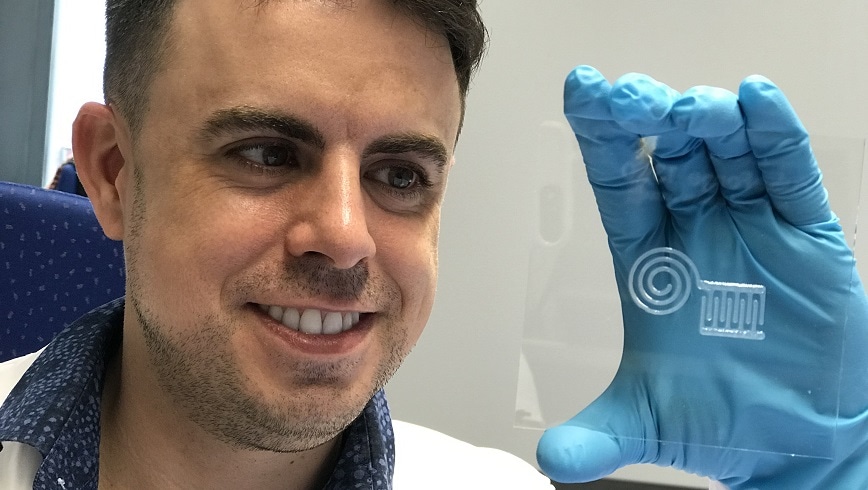Oct 10 2019
Physiological parameters in the blood can be measured without painful pricks. Empa scientists have now collaborated with a Canadian team to build flexible, biocompatible nanocellulose sensors that can be stuck to the skin.
 Empa researcher Gilberto Siqueira demonstrates the newly printed nanocellulose circuit. After a subsequent drying, the material can be further processed. (Image credit: Empa)
Empa researcher Gilberto Siqueira demonstrates the newly printed nanocellulose circuit. After a subsequent drying, the material can be further processed. (Image credit: Empa)
The 3D-printed analytic chips composed of renewable raw materials will even be biodegradable in the future.
The concept of measuring parameters applicable to human health via the skin has already entered medical diagnostics. Diabetics, for instance, can painlessly measure their blood sugar level with a sensor rather than having to prick their fingers.
Empa scientists, along with scientists from Canada, have currently built an innovative flexible sensor that lies on the skin surface and is biocompatible as it is composed of nanocellulose.
A transparent Foil Made of Wood
Nanocellulose is an economical, renewable raw material, which can be acquired in the form of fibers and crystals, for instance, from wood. But the true appearance of a tree does not have anything to do with the gelatinous substance, which can comprise cellulose nanofibers and cellulose nanocrystals.
Algae, bacteria, or residues from agrarian production are other sources of the material. Thus, apart from being comparatively easy and sustainable to obtain, nanocellulose has mechanical properties that make the “super pudding” an exciting product.
For example, it is possible to develop new composite materials based on nanocellulose for probable use as transparent packaging films, surface coatings, or even to make daily objects like beverage bottles.
Researchers at Empa’s Cellulose & Wood Materials lab and Woo Soo Kim from the Simon Fraser University in Burnaby, Canada, are also paying attention to another property of nanocellulose: biocompatibility. Since the material is obtained from natural resources, it is especially suitable for biomedical research.
With the goal of creating biocompatible sensors that can measure vital metabolic values, the scientists used nanocellulose as an “ink” in 3D-printing processes. The sensors were made electrically conductive by blending the ink with silver nanowires. The scientists established the precise ratio of nanocellulose and silver threads so that a 3D network could develop.
Just Like Spaghetti—Only a Wee Bit Smaller
It so happened that cellulose nanofibers are better matched than cellulose nanocrystals to create a cross-linked matrix with the minute silver wires.
Cellulose nanofibers are flexible similar to cooked spaghetti, but with a diameter of only about 20 nanometers and a length of just a few micrometers.
Gilberto Siqueira, Researcher, Empa
Finally, the researchers were successful in building sensors that measure medically relevant metabolic factors, for example, the concentration of potassium, calcium, and ammonium ions. The electrochemical skin sensor transmits its results wirelessly to a computer for further processing of data. The thickness of the miniature biochemistry lab on the skin is just half a millimeter.
While the miniature biochemistry lab on the skin has the potential to determine ion concentrations exactly and dependably, the scientists are already involved in creating an updated model.
In the future, we want to replace the silver particles with another conductive material, for example on the basis of carbon compounds.
Gilberto Siqueira, Researcher, Empa
This would render the medical nanocellulose sensor biocompatible, as well as fully biodegradable.